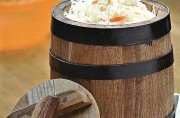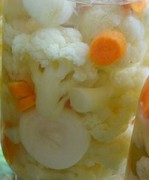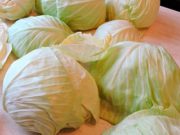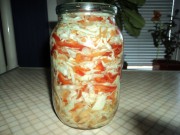Lightly salted cabbage - simple recipes and unusual tastes
Lightly salted cabbage is a dish that you won’t be ashamed to put on the table, and if you eat it all, you won’t feel sorry. Lightly salted cabbage is used for stewing and preparing first courses. It is rich in vitamins, and simply, properly salted cabbage is incredibly tasty.
Sometimes lightly salted cabbage is called “sauerkraut,” but this is somewhat wrong. In the old days, when salt was in short supply, cabbage was fermented without salt. It was finely chopped, placed in barrels mixed with garlic and tamped thoroughly until the juice appeared. After some time, bacteria developed in the cabbage juice, which caused fermentation, and the cabbage fermented in its own juice. This process was long, and the cabbage acquired its characteristic sour taste only after a month.
With the use of salt, the fermentation process occurs a little faster, and within a week the lightly salted cabbage turns out to be “sauerkraut.”
There are many recipes, but there are basic rules:
- The cabbage should be juicy, without rot or wilted leaves.
- It is necessary to take not iodized salt, but regular salt - rock salt.
- Do not use aluminum or copper containers for pickling cabbage. Ideally, this is a wooden barrel, but plastic buckets or glass bottles will also work.
Chop the cabbage into strips and sprinkle it with salt. There are no exact measurements of salt, and this is done “by eye”. And remember that it is better not to add enough salt. It only speeds up the process, but the taste is provided by bacteria.If you over-salt the cabbage, bacteria will not be able to develop and the cabbage will not ferment as it should. It will just be salty and soft.

As an additive and variety of taste, carrots (grated on a coarse grater), bell pepper, or beets (cut into strips) are usually added to cabbage. All these are optional additives and you can experiment.

Again, everything is mixed thoroughly, with pressing. The cabbage should release a little juice already on the table. Then, place the cabbage in a pan (bucket) and compact it well.
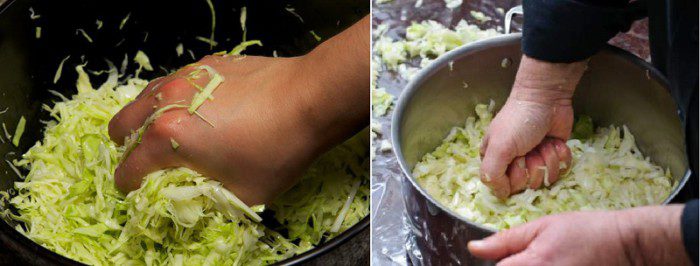
Don't stuff the cabbage to capacity. When fermenting, the fermentation process actively occurs and juice can pour out through the top.
Place a wooden circle or flat plate on top of the cabbage, and place a weight on top. The cabbage must be completely covered with juice, otherwise it will become moldy.
And now the most important thing:
Cabbage should be fermented in a warm place for at least 4 days. Every day you need to remove the pressure and pierce the cabbage to the very bottom with a wooden stick or spatula. When pickling, cabbage releases hydrogen sulfide and must be released so that it does not go rotten.
On days 5-7, transfer the cabbage into clean three-liter bottles, close them with plastic lids and take them to a cool place.

Lightly salted cabbage is ready, it can be used for stews, stewing, boiling, or as a stand-alone very useful salad for boiled potatoes.
Watch the video on how to cook lightly salted cabbage with apples and cranberries:



